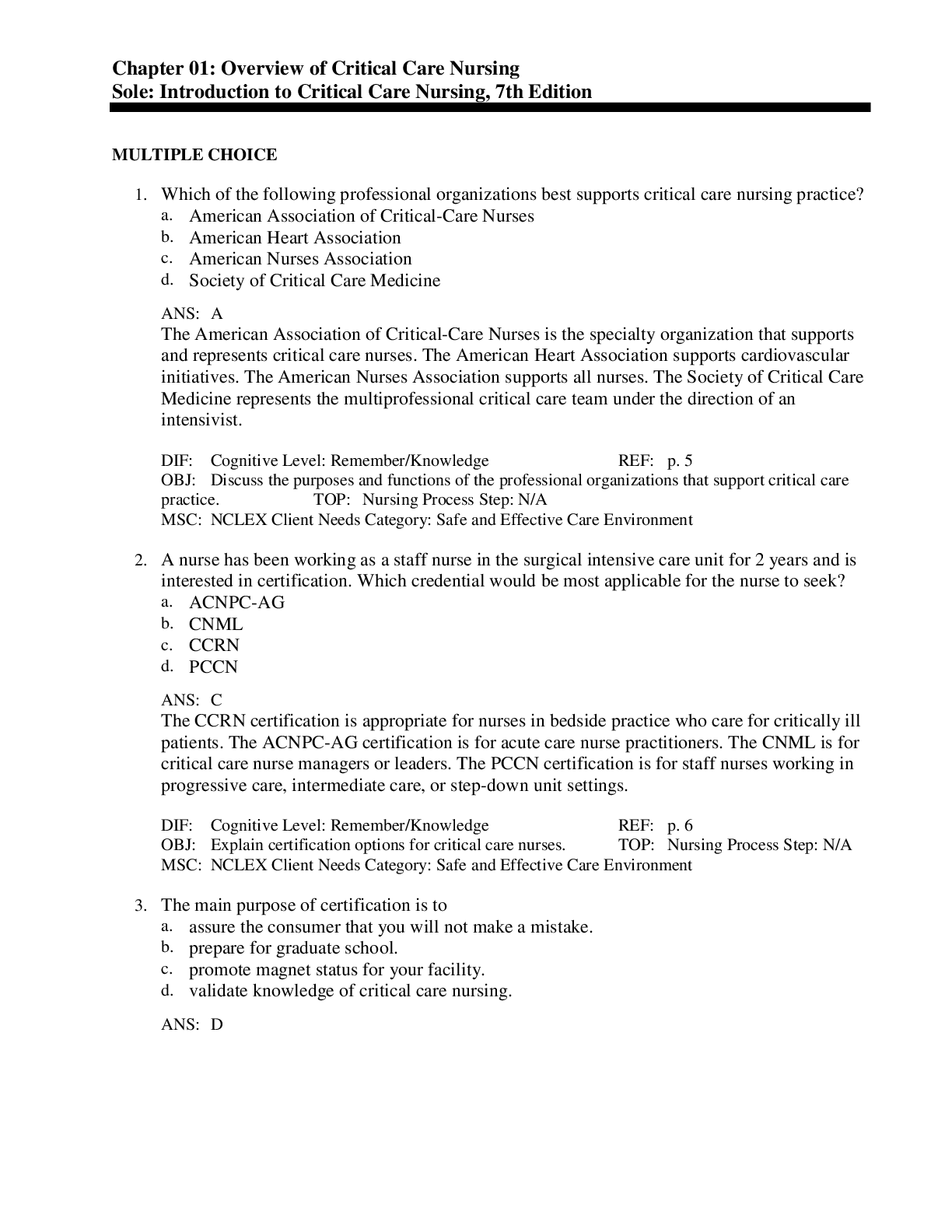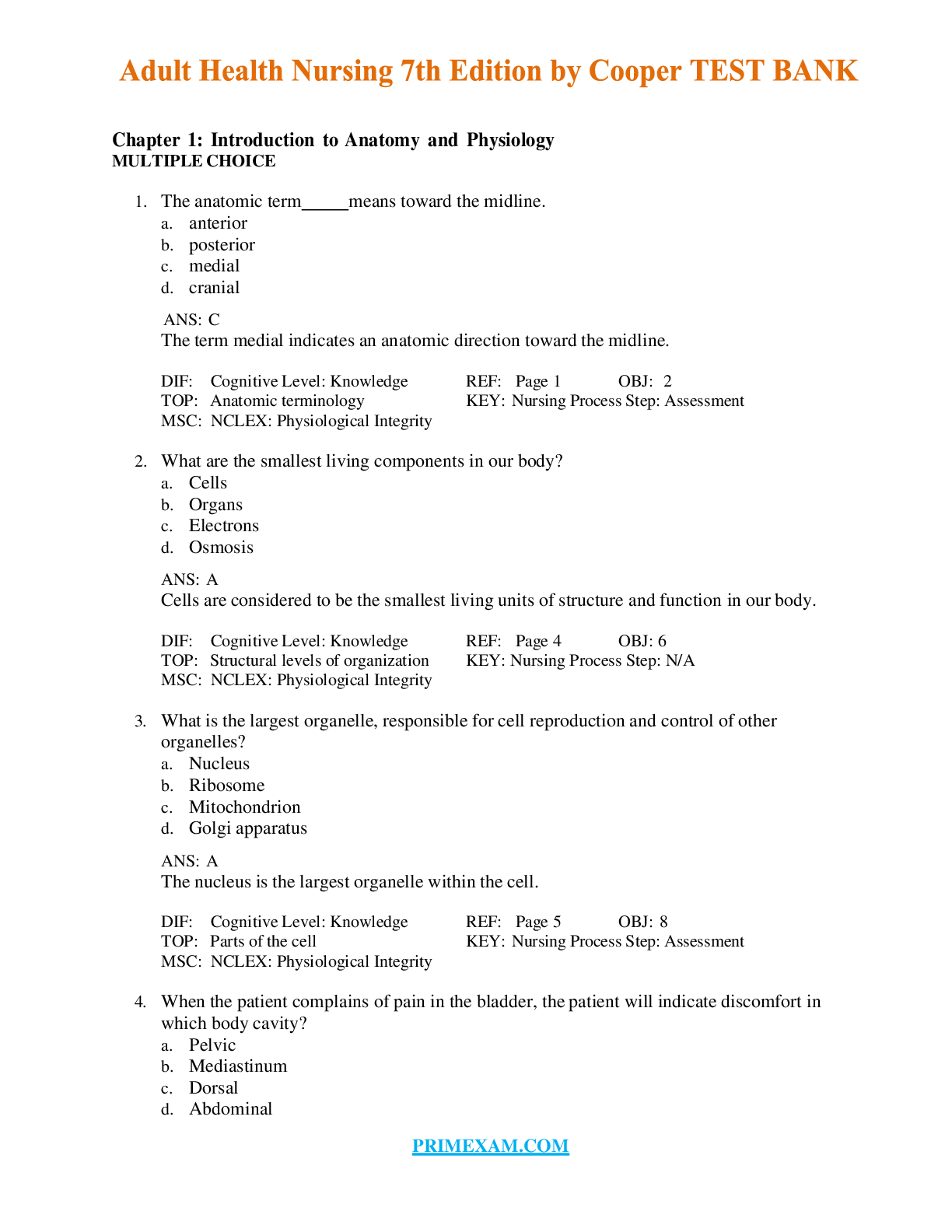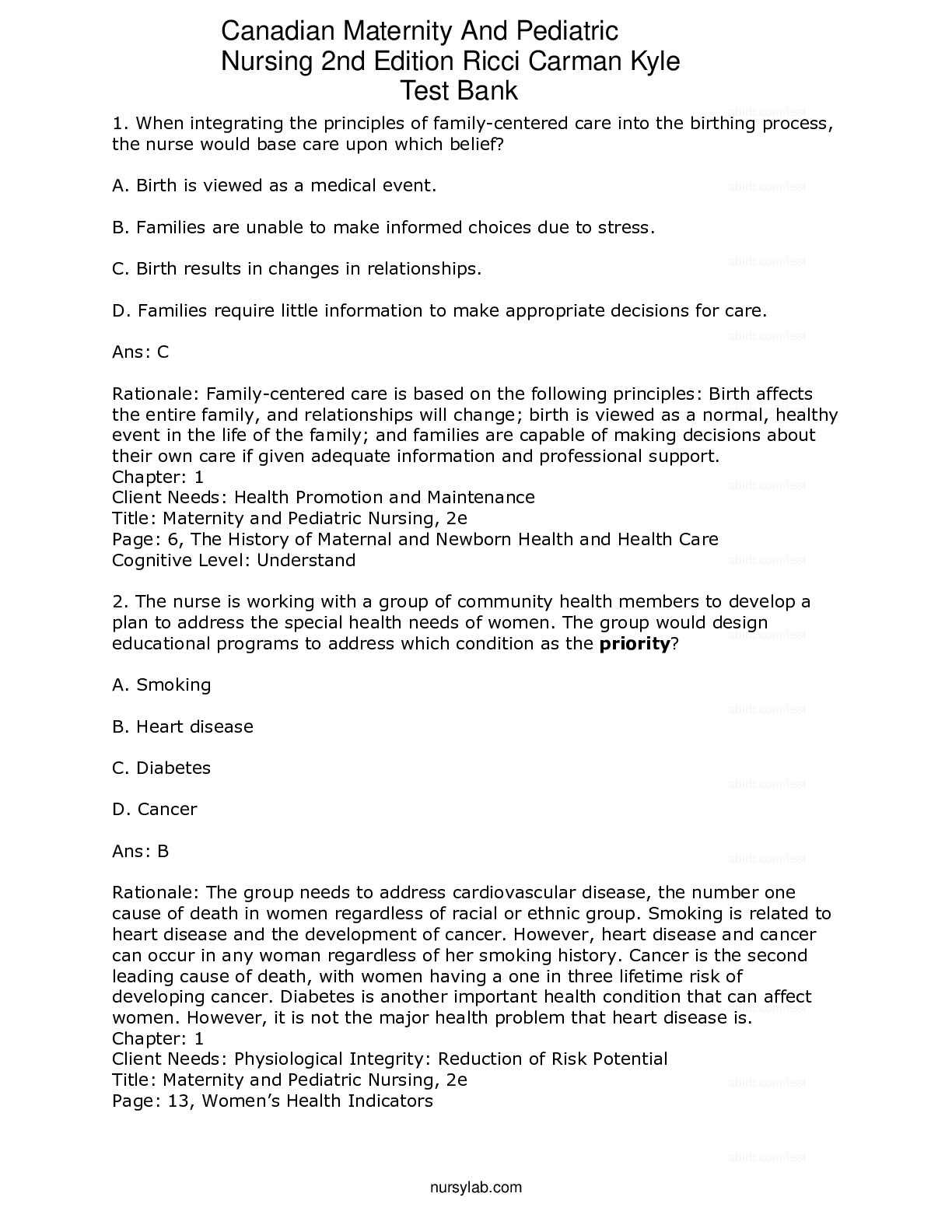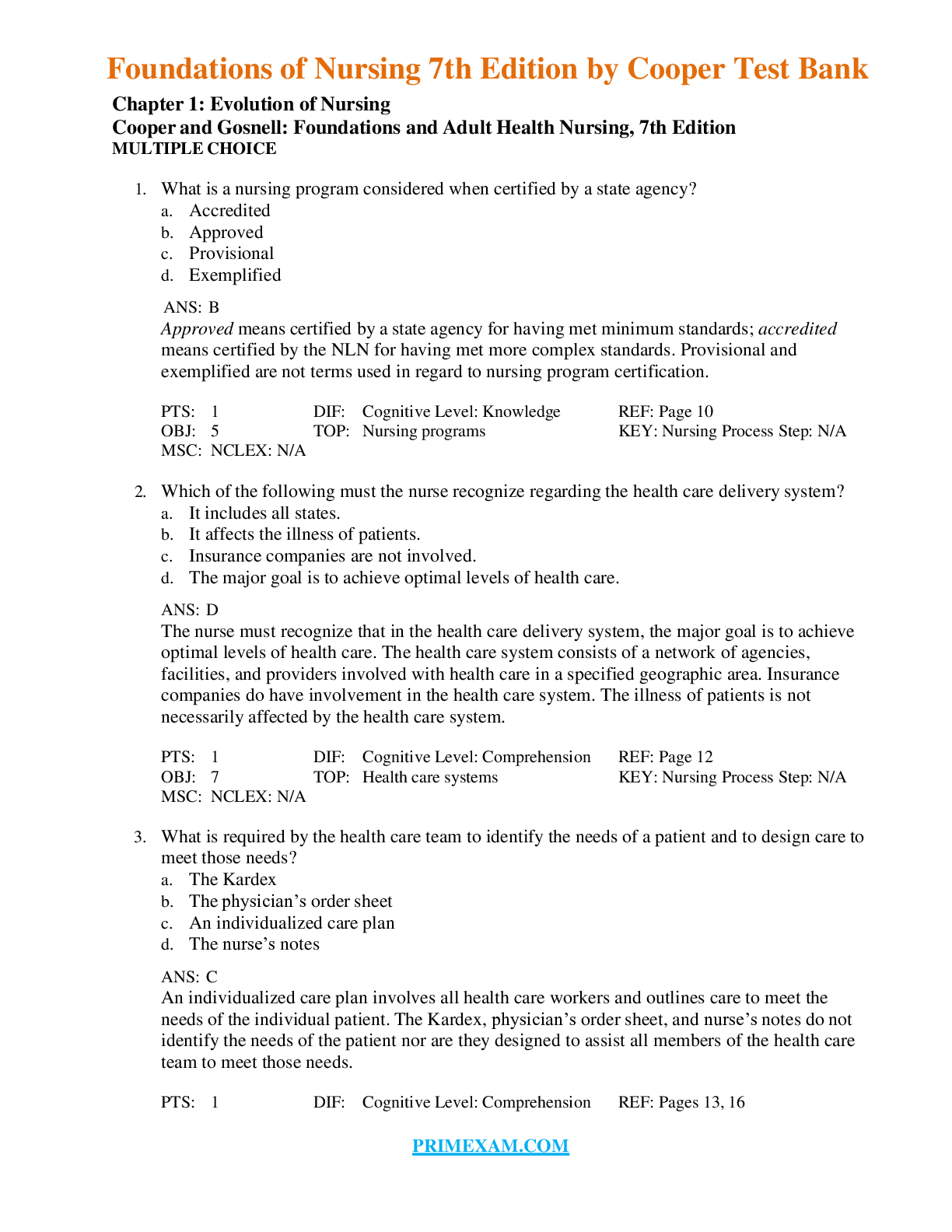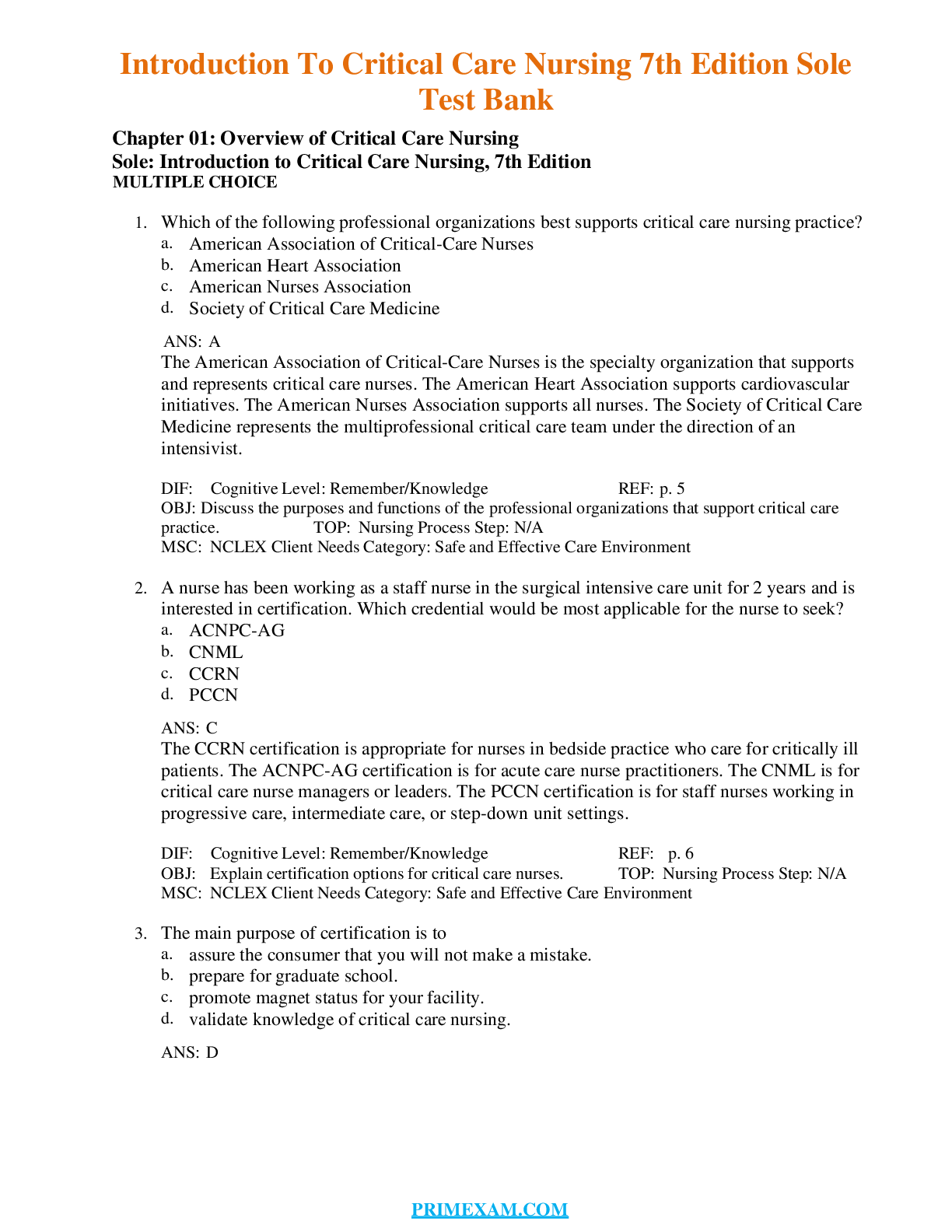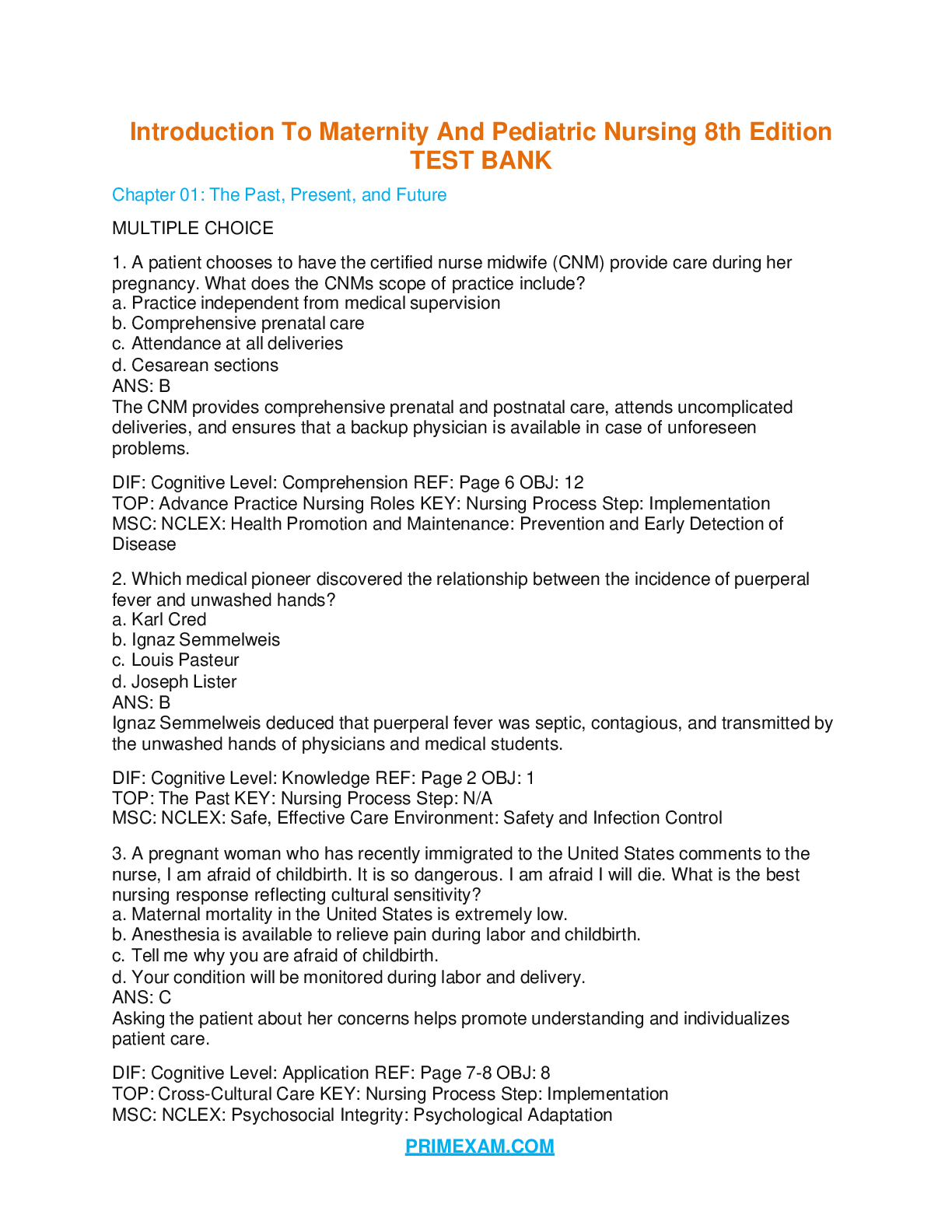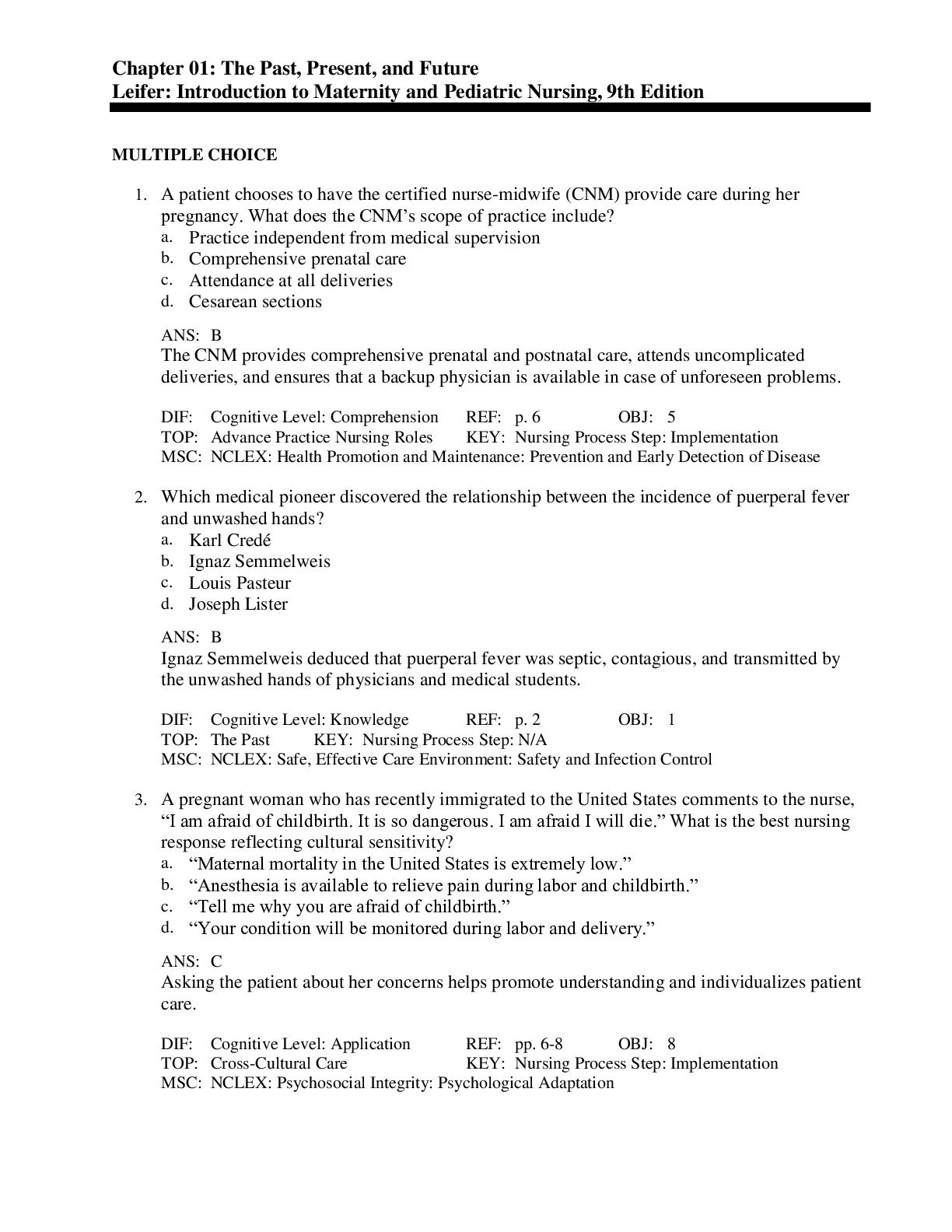*NURSING > TEST BANK > INTRODUCTION TO MATERNITY AND PEDIATRIC NURSING 7TH EDITION LEIFER TEST BANK: The Family After Birth (All)
INTRODUCTION TO MATERNITY AND PEDIATRIC NURSING 7TH EDITION LEIFER TEST BANK: The Family After Birth,100% CORRECT
Document Content and Description Below
INTRODUCTION TO MATERNITY AND PEDIATRIC NURSING 7TH EDITION LEIFER TEST BANK: The Family After Birth MULTIPLE CHOICE 1. The nurse is assessing a newborn. What sign of hypoglycemia does the nurse rec... ord? a. Increased nasal mucus b. Increased temperature c. Active muscle movements d. High-pitched cry ANS: D There are many signs of hypoglycemia in the newborn. One is a high-pitched cry. DIF: Cognitive Level: Comprehension REF: Page 219 OBJ: 9 TOP: Signs of Hypoglycemia KEY: Nursing Process Step: Data Collection MSC: NCLEX: Physiological Integrity: Reduction of Risk 2. What would the nurse expect to find when assessing the fundus of the uterus immediately after delivery? a. Well-contracted with its upper border at or just below the umbilicus b. Well-contracted with its upper border three or four fingerbreadths above the umbilicus c. Relaxed with its upper border level with the umbilicus d. Relaxed with its upper border two or three fingerbreadths below the umbilicus ANS: A Immediately after the placenta is expelled, the uterine fundus can be felt as a firm mass, about the size of a grapefruit, at the level of the umbilicus. DIF: Cognitive Level: Comprehension REF: Page 200 OBJ: 2 TOP: Fundus Assessment KEY: Nursing Process Step: Data Collection MSC: NCLEX: Physiological Integrity: Physiological Adaptation 3. What statement made by a new mother indicates she needs additional information about breastfeeding? a. “I let the baby nurse 10 to 15 minutes on the first breast and then switch to the other breast.” b. “The baby needs to nurse at least 5 minutes on the breast to get the hindmilk.” c. “The baby has been nursing every 2 to 3 hours.” d. “If the baby gets fussy between feedings, I give her a bottle of water.” ANS: D Supplemental feedings of formula or water should not be offered to a healthy newborn who is breastfeeding. DIF: Cognitive Level: Comprehension REF: Page 223-227 OBJ: 14 TOP: Breastfeeding—Supplemental Feedings KEY: Nursing Process Step: Evaluation MSC: NCLEX: Physiological Integrity: Physiological Adaptation 4. After delivery, the nurse’s assessment reveals a soft, boggy uterus located above the level of the umbilicus. What is the most appropriate nursing intervention? a. Notify the physician. b. Massage the fundus. c. Initiate measures that encourage voiding. d. Position the patient flat. ANS: B A poorly contracted uterus should be massaged until firm to prevent hemorrhage. DIF: Cognitive Level: Application REF: Page 202 OBJ: 9 TOP: Boggy Uterus KEY: Nursing Process Step: Implementation MSC: NCLEX: Physiological Integrity: Physiological Adaptation 5. What type of lochia will the nurse assess initially after delivery? a. Serosa b. Rubra c. Alba d. Vaginalis ANS: B The initial vaginal discharge after delivery is called lochia rubra. It is red and moderately heavy. Lochia rubra lasts for up to 3 days postpartum. DIF: Cognitive Level: Knowledge REF: Page 202 OBJ: 4 TOP: Lochia Rubra KEY: Nursing Process Step: Implementation MSC: NCLEX: Physiological Integrity: Physiological Adaptation 6. A woman will be discharged 48 hours after a vaginal delivery. When planning discharge teaching, the nurse would include what information about lochia? a. Lochia should disappear 2 to 4 weeks postpartum. b. It is normal for the lochia to have a slightly foul odor. c. A change in lochia from pink to bright red should be reported. d. A decrease in flow will be noticed with ambulation and activity. ANS: C A return to bright red lochia rubra may indicate a late postpartum hemorrhage and must be reported. DIF: Cognitive Level: Application REF: Page 203 OBJ: 18 TOP: Hemorrhage KEY: Nursing Process Step: Planning MSC: NCLEX: Physiological Integrity: Physiological Adaptation 7. What instruction should the nurse teach the postpartum woman about perineal self-care? a. Perform perineal self-care at least twice a day. b. Cleanse with warm water in a squeeze bottle from front to back. c. Remove perineal pads from the rectal area toward the vagina. d. Use cool water to decrease edema of the perineum. ANS: B Cleansing from front to back prevents contamination from the rectal area. DIF: Cognitive Level: Application REF: Page 204 OBJ: 2 TOP: Perineal Care KEY: Nursing Process Step: Implementation MSC: NCLEX: Health Promotion and Maintenance: Prevention and Early Detection of Disease 8. A postpartum woman is not immune to rubella. What will the nurse expect? a. The rubella virus vaccine should be administered before discharge. b. The woman should receive the rubella virus vaccine at her 6-week postpartum checkup. c. The woman should be instructed not to get pregnant until she receives the rubella vaccine. d. No intervention is indicated at this time because the woman is not at risk for rubella. ANS: A The woman who is not immune to rubella is immunized in the immediate postpartum period because there is no danger of her being pregnant. DIF: Cognitive Level: Comprehension REF: Page 209 OBJ: 2 TOP: Rubella KEY: Nursing Process Step: Planning MSC: NCLEX: Health Promotion and Maintenance: Prevention and Early Detection of Disease 9. Which statement indicates the new mother is breastfeeding correctly? a. “I will alternate breasts when feeding the baby.” b. “I keep the baby on a 4-hour feeding schedule.” c. “I let the baby stay on the first breast only 5 minutes.” d. “I put only the nipple in the baby’s mouth when I am breastfeeding.” ANS: A Alternating breasts for feeding increases milk production, particularly hindmilk, which has a higher protein and fat content. DIF: Cognitive Level: Comprehension REF: Page 224, Table 9-4 OBJ: 14 TOP: Breastfeeding KEY: Nursing Process Step: Evaluation MSC: NCLEX: Physiological Integrity: Physiological Adaptation 10. The nurse is counseling a lactating mother about diet. What would the nurse include with this information? a. Consume 500 more calories than her usual prepregnancy diet. b. Eat less meat and more fruits and vegetables. c. Drink 3 to 4 tall glasses of fluid daily. d. Eat 1000 more calories than her usual prepregnancy diet. ANS: A To maintain nutrient stores while breastfeeding, the mother needs 500 additional calories each day over her prepregnancy diet. DIF: Cognitive Level: Comprehension REF: Page 230 OBJ: 15 TOP: Breastfeeding—Maternal Nutrition KEY: Nursing Process Step: Implementation MSC: NCLEX: Physiological Integrity: Physiological Adaptation 11. A woman asks about resumption of her menstrual cycle after childbirth. What should the nurse respond? a. A woman will not ovulate in the absence of menstrual flow. b. Most nonlactating women resume menstruation about 2 months postpartum. c. Generally, a woman does not ovulate in the first few cycles after childbirth. d. The return of menstruation is delayed when a woman does not breastfeed. ANS: B Menstrual periods resume in about 6 to 8 weeks if the woman is not breastfeeding. DIF: Cognitive Level: Comprehension REF: Page 205 OBJ: 4 TOP: Return of Menses KEY: Nursing Process Step: Implementation MSC: NCLEX: Physiological Integrity: Physiological Adaptation 12. In what situation will the physician order RhoGAM? a. An unsensitized Rh-negative mother has an Rh-positive infant. b. An Rh-negative mother becomes sensitized. c. A sensitized infant has a rising bilirubin level. d. An unsensitized infant exhibits no outward signs. ANS: A The Rh-negative woman should receive RhoGAM within 72 hours after the birth of an Rh- positive infant. DIF: Cognitive Level: Analysis REF: Page 209 OBJ: 4 TOP: RhoGAM KEY: Nursing Process Step: Implementation MSC: NCLEX: Health Promotion and Maintenance: Prevention and Early Detection of Disease 13. After birth, the nurse quickly dries and wraps the newborn in a blanket. How does this action prevent heat loss? a. Conduction b. Radiation c. Evaporation d. Convection ANS: C Newborns lose heat quickly after birth as fluid evaporates from their bodies. DIF: Cognitive Level: Comprehension REF: Page 216, Table 9-3 OBJ: 2 TOP: Thermoregulation KEY: Nursing Process Step: Implementation MSC: NCLEX: Physiological Integrity: Physiological Adaptation 14. What will the nurse’s instructions for a new mother to care for the infant’s umbilical cord include? a. Keeping the area covered with a sterile dressing b. Dressing the stump with antibiotic ointment at every diaper change c. Fastening the diaper low to allow for air circulation d. Giving the newborn a daily tub bath until the cord falls off ANS: C Diaper placement below the umbilical stump allows for drying by air circulation. DIF: Cognitive Level: Application REF: Page 218-219, Skill 9-6 OBJ: 2 TOP: Umbilical Cord Care KEY: Nursing Process Step: Implementation MSC: NCLEX: Health Promotion and Maintenance: Prevention and Early Detection of Disease 15. A new mother states her preference to formula feed her newborn. What will the nurse planning discharge instructions tell her to help suppress lactation and promote comfort? a. Wear a well-fitting bra continuously for several days. b. Stand in a warm shower, letting the water spray over the breasts. c. Express small amounts of milk from the breasts several times a day. d. Massage the breasts when they ache. ANS: A When a mother does not wish to breastfeed, a snug bra worn around the clock can help alleviate discomfort from engorgement. DIF: Cognitive Level: Application REF: Page 230 OBJ: 18 TOP: Suppression of Lactation KEY: Nursing Process Step: Planning MSC: NCLEX: Health Promotion and Maintenance: Prevention and Early Detection of Disease 16. On the second postpartum day, a mother bathed her newborn for the first time. She tells the nurse, “I don’t think I did it right.” What postpartum psychological stage is this woman most likely in based on this comment? a. Taking in b. Taking hold c. Letting go d. Settling down ANS: B In phase 2, taking hold, the mother begins to initiate action and becomes interested in caring for the infant. In doing so, she may become critical of her performance. DIF: Cognitive Level: Analysis REF: Page 212, Table 9-2 OBJ: 6 TOP: Postpartum Psychological Stages KEY: Nursing Process Step: Data Collection MSC: NCLEX: Psychosocial Integrity: Physiological Adaptation 17. A primipara tells the nurse, “My afterpains get worse when I am breastfeeding.” What is the most appropriate nursing response? a. “I’ll get you some aspirin to relieve the cramping that you feel.” b. “Afterpains are more intense with your first baby.” c. “Breastfeeding releases a hormone that causes your uterus to contract.” d. “A change of position when you’re breastfeeding might help.” ANS: C Breastfeeding mothers may have more afterpains because infant suckling causes the posterior pituitary to release oxytocin, which is a hormone that contracts the uterus. DIF: Cognitive Level: Application REF: Page 201 OBJ: 2 TOP: Afterpains with Breastfeeding KEY: Nursing Process Step: Implementation MSC: NCLEX: Physiological Integrity: Physiological Adaptation 18. A new mother has decided not to breastfeed her newborn. What information will the nurse include when planning to teach the mother about formula feeding? a. Positioning the bottle so that the nipple is full of formula during the entire feeding b. Heating the infant formula in a microwave c. Burping the infant after 4 ounces and again when the bottle is empty d. Propping a bottle for a feeding ANS: A The nipple of the bottle should be kept full of formula to reduce the amount of air the infant swallows. DIF: Cognitive Level: Comprehension REF: Page 232, Skill 9-7 OBJ: 17 TOP: Formula Feeding KEY: Nursing Process Step: Planning MSC: NCLEX: Physiological Integrity: Reduction of Risk 19. In the recovery room, the nurse checks the newly delivered woman’s fundus following a cesarean section. How would the nurse proceed with this assessment? a. Palpate from the midline to the side of the body. b. Palpate from the symphysis to the umbilicus. c. Palpate from the side of the uterus to the midline. d. Massage the abdomen in a circular motion. ANS: C The fundus is checked gently by walking the fingers from the side of the uterus to the midline. DIF: Cognitive Level: Application REF: Page 209 OBJ: 5 TOP: Postpartum Cesarean Assessment KEY: Nursing Process Step: Data Collection MSC: NCLEX: Health Promotion and Maintenance: Prevention and Early Detection of Disease 20. The nurse instructed a postpartum woman about storing and freezing breast milk. What statement by the woman leads the nurse to determine that the teaching was effective? a. “I can thaw frozen breast milk in the microwave.” b. “I’ll put enough breast milk for one day in a container.” c. “Breast milk can be stored in glass containers.” d. “Breast milk can be kept in the refrigerator for up to 3 months.” ANS: C Breast milk can be safely stored in glass or clear hard plastic containers. DIF: Cognitive Level: Comprehension REF: Page 229 OBJ: 14 TOP: Storing Breast Milk KEY: Nursing Process Step: Evaluation MSC: NCLEX: Safe, Effective Care Environment: Safety and Infection Control 21. What should the nurse implement for security purposes when bringing the infant from the nursery to the mother? a. Ask, “Is this your band number?” b. Confirm room number of mother. c. Ask the mother to identify herself verbally. d. Check the band number of the infant with that of the mother. ANS: D The nurse should check the band number of the infant with that of the mother by asking the mother to verbally read the number. DIF: Cognitive Level: Application REF: Page 216-217 OBJ: 8 TOP: Security Identification Procedure KEY: Nursing Process Step: Implementation MSC: NCLEX: Safe, Effective Care Environment: Safety and Infection Control 22. Below what blood glucose level is the newborn considered hypoglycemic? a. Below 70 mg/dL b. Below 60 mg/dL c. Below 50 mg/dL d. Below 40 mg/dL ANS: D A blood glucose level of less than 40 mg/dL is considered hypoglycemic. If the screening sample is below 40 mg/dL, a venous sample will be drawn. After the blood has been drawn, the infant should be fed to prevent a further drop. DIF: Cognitive Level: Comprehension REF: Page 219 OBJ: 8 TOP: Hypoglycemia KEY: Nursing Process Step: Planning MSC: NCLEX: Physiological Integrity: Reduction of Risk 23. The nurse is caring for a woman of Middle Eastern descent on the first postpartum day. Education is provided regarding instruction on use of a sitz bath. What documentation best indicates that the woman has understood the provided instruction? a. Patient correctly performed return demonstration. b. Patient indicated understanding by nodding head with instruction. c. Patient verbalizes “I understand.” d. Family member indicates patient understands procedure. ANS: A The nurse may need an interpreter to understand and provide optimal care to the woman and her family. If possible, when discussing sensitive information the interpreter should not be a family member, who might interpret selectively. The interpreter should not be of a group that is in social or religious conflict with the patient and her family, an issue that might arise in many Middle Eastern cultures. It is also important to remember that an affirmative nod from the woman may be a sign of courtesy to the nurse rather than a sign of understanding or agreement. DIF: Cognitive Level: Application REF: Page 200 OBJ: 3 TOP: Cultural Influences KEY: Nursing Process Step: Evaluation MSC: NCLEX: Physiological Integrity: Cultural Awareness 24. A woman has given birth to an unresponsive newborn that NICU staff are attempting to revive. The patient and her husband are grief stricken and request the child be baptized immediately. What is the nurse’s most appropriate action? a. Contact the hospital chaplain. b. Request the couple’s clergy. c. Baptize the newborn. d. Ask the physician to baptize the newborn. ANS: C If the condition of a newborn is poor, the parents may wish to have a baptism performed. The minister or priest is notified. However this is an emergency, so the nurse may perform the baptism by pouring water on the infant’s forehead while saying, “I baptize you in the name of the Father, and of the Son, and of the Holy Spirit.” If there is any doubt as to whether the infant is alive, the baptism is given conditionally: “If you are capable of receiving baptism, I baptize you in the name of the Father, and of the Son, and of the Holy Spirit.” The physician is attending to the patient’s immediate health needs. DIF: Cognitive Level: Application REF: Page 213 OBJ: 7 TOP: Grieving Parents KEY: Nursing Process Step: Implementation MSC: NCLEX: Physiological Integrity: Grief and Loss 25. A woman required a cesarean section for safe delivery of her newborn. She is planning to breastfeed and verbalized concern about pain. What is the best suggestion by the nurse? a. “Consider formula feeding for the first few days.” b. “Pumping breast milk would be best for now.” c. “Take pain medication 30 to 40 minutes prior to nursing.” d. “Use the football hold when breastfeeding.” ANS: D The best answer is to encourage use of the football hold to decrease pressure on the operative site. There is no indication for the woman to formula feed or pump. Some pain medications should not be taken when breastfeeding. DIF: Cognitive Level: Application REF: Page 224-225, Figure 9-10 OBJ: 12 TOP: Breastfeeding KEY: Nursing Process Step: Implementation MSC: NCLEX: Physiological Integrity: Basic Care and Comfort MULTIPLE RESPONSE 26. Which assessments would lead the nurse to determine the gestational age of the infant as preterm? (Select all that apply.) a. Thin, transparent skin b. Vernix only in the body creases c. Folded ear springs back slowly d. Breast tissue under the nipple e. Creases over entire sole ANS: A, C The only signs of preterm are the thin skin and the slowly responding ear. DIF: Cognitive Level: Application REF: Page 217 OBJ: 2 TOP: Gestational Age Assessment KEY: Nursing Process Step: Data Collection MSC: NCLEX: Health Promotion and Maintenance: Growth and Development 27. The nurse is giving a shower to a patient who had a cesarean section 2 days previously. What interventions should be included before, during, and after the shower? (Select all that apply.) a. Leave abdominal dressing open to air. b. Position patient with back to water stream. c. Cover infusion site with rubber glove. d. Provide a shower chair. e. Confirm ambulation ability. ANS: B, C, D, E The patient should be evaluated for ambulatory ability, and the abdominal dressing and infusion site should be covered with a waterproof cover. The patient should be provided a shower chair and positioned with her back to the water stream. DIF: Cognitive Level: Application REF: Page 209-211 OBJ: 5 TOP: Postpartum Shower KEY: Nursing Process Step: Implementation MSC: NCLEX: Physiological Integrity: Basic Care and Comfort 28. What postpartum exercises should the nurse teach a patient who had a vaginal delivery yesterday? (Select all that apply.) a. Abdominal tighteners b. Head lift c. Pelvic tilt d. Kegel exercises e. Leg lifts ANS: A, B, C, D Exercises for postpartum involution such as abdominal tighteners, head lifts, pelvic tilts, and Kegel exercises are acceptable. Leg lifts are too strenuous early in the postpartum period. DIF: Cognitive Level: Comprehension REF: Page 208 OBJ: 18 TOP: Postpartum Exercises KEY: Nursing Process Step: Implementation MSC: NCLEX: Physiological Integrity: Physiological Adaptation 29. While instructing a new mother on formula preparations, the nurse would include what types? (Select all that apply.) a. Ready-to-feed formula b. Concentrated liquid formula c. Powdered formula d. Cow’s milk e. Canned evaporated milk ANS: A, B, C Formula choices are ready-to-use, concentrated liquid formula that will be diluted according to the infant’s needs and powdered formula that is mixed as needed. Cow’s milk and canned evaporated milk are unsuitable because they are nutritionally inadequate and stress the kidneys. DIF: Cognitive Level: Comprehension REF: Page 231 OBJ: 17 TOP: Formula Choices KEY: Nursing Process Step: Implementation MSC: NCLEX: Health Promotion and Maintenance: Growth and Development 30. The nurse is instructing a woman at 6 months postpartum on weaning her infant from breastfeeding. What interventions will the nurse suggest? (Select all that apply.) a. Omit newborn’s favorite feeding first. b. Eliminate one feeding at a time. c. Expect the need for comfort feeding. d. Formula will need to be provided to substitute for feeding. e. Pump breasts in place of eliminated feeding. ANS: B, C, D When weaning a newborn from breastfeeding, the mother should eliminate the favorite feeding last. One feeding should be eliminated at a time, and the need for comfort feeding should be expected. In younger infants formula will need to be substituted. The mother should not be instructed to pump in place of eliminated feeding or the breasts will continue to produce milk. DIF: Cognitive Level: Comprehension REF: Page 230 OBJ: 16 TOP: Weaning KEY: Nursing Process Step: Implementation MSC: NCLEX: Physiological Integrity: Basic Care and Comfort COMPLETION 31. The nurse assesses a 6-inch stain of lochia rubra on a pad that was worn for 2 hours. The nurse would document this as a(n) amount of lochia. ANS: moderate A 6-inch stain on a pad worn for 2 hours is regarded as a moderate amount of lochia discharge. DIF: Cognitive Level: Application REF: Page 202, Skill 9-2 OBJ: 2 TOP: Estimating Lochia Discharge KEY: Nursing Process Step: Data Collection MSC: NCLEX: Physiological Integrity: Reduction of Risk 32. The nurse explains that the three infections that are contraindications to breastfeeding are , , and . ANS: human immunodeficiency virus (HIV), hepatitis B, hepatitis C Mothers who are HIV positive should not breastfeed because the virus can be transmitted through breast milk, as can the viruses that cause hepatitis B and C. DIF: Cognitive Level: Comprehension REF: Page 222 OBJ: 13 TOP: Contraindication for Breastfeeding KEY: Nursing Process Step: Implementation MSC: NCLEX: Health Promotion and Maintenance: Prevention and Early Detection of Disease 33. The hormone responsible for milk production is . ANS: prolactin During pregnancy, the woman secretes high levels of prolactin, the hormone that causes milk production. Following delivery, increased levels of prolactin lead to lactation. DIF: Cognitive Level: Knowledge REF: Page 223 OBJ: 11 TOP: Prolactin KEY: Nursing Process Step: N/A MSC: NCLEX: Physiological Integrity: Physiological Adaptation 34. The hormone responsible for milk “let-down” or ejection from the breasts is . ANS: oxytocin The milk “let-down” reflex is caused by the hormone oxytocin. DIF: Cognitive Level: Knowledge REF: Page 223 OBJ: 11 TOP: Oxytocin KEY: Nursing Process Step: N/A MSC: NCLEX: Physiological Integrity: Physiological Adaptation 35. refers to changes that the reproductive organs, particularly the uterus, undergo after birth to return to their prepregnancy size and condition. ANS: Involution Involution refers to changes that the reproductive organs, particularly the uterus, undergo after birth to return to their prepregnancy size and condition. DIF: Cognitive Level: Knowledge REF: Page 200 OBJ: 1 TOP: Puerperium KEY: Nursing Process Step: Data Collection MSC: NCLEX: Physiological Integrity: Physiological Adaptation NURSINGTB.COM [Show More]
Last updated: 1 year ago
Preview 1 out of 23 pages
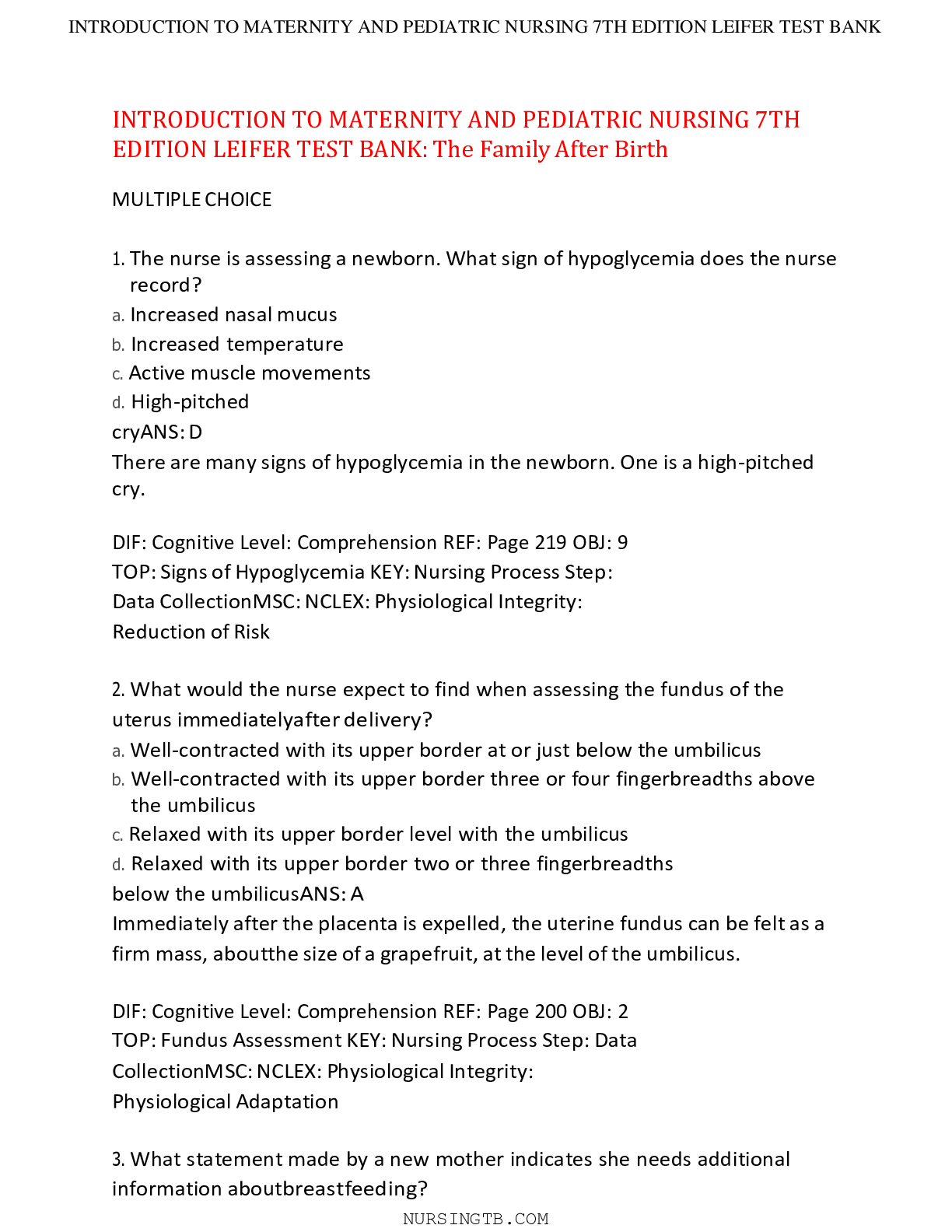
Reviews( 0 )
Document information
Connected school, study & course
About the document
Uploaded On
Dec 20, 2022
Number of pages
23
Written in
Additional information
This document has been written for:
Uploaded
Dec 20, 2022
Downloads
0
Views
35

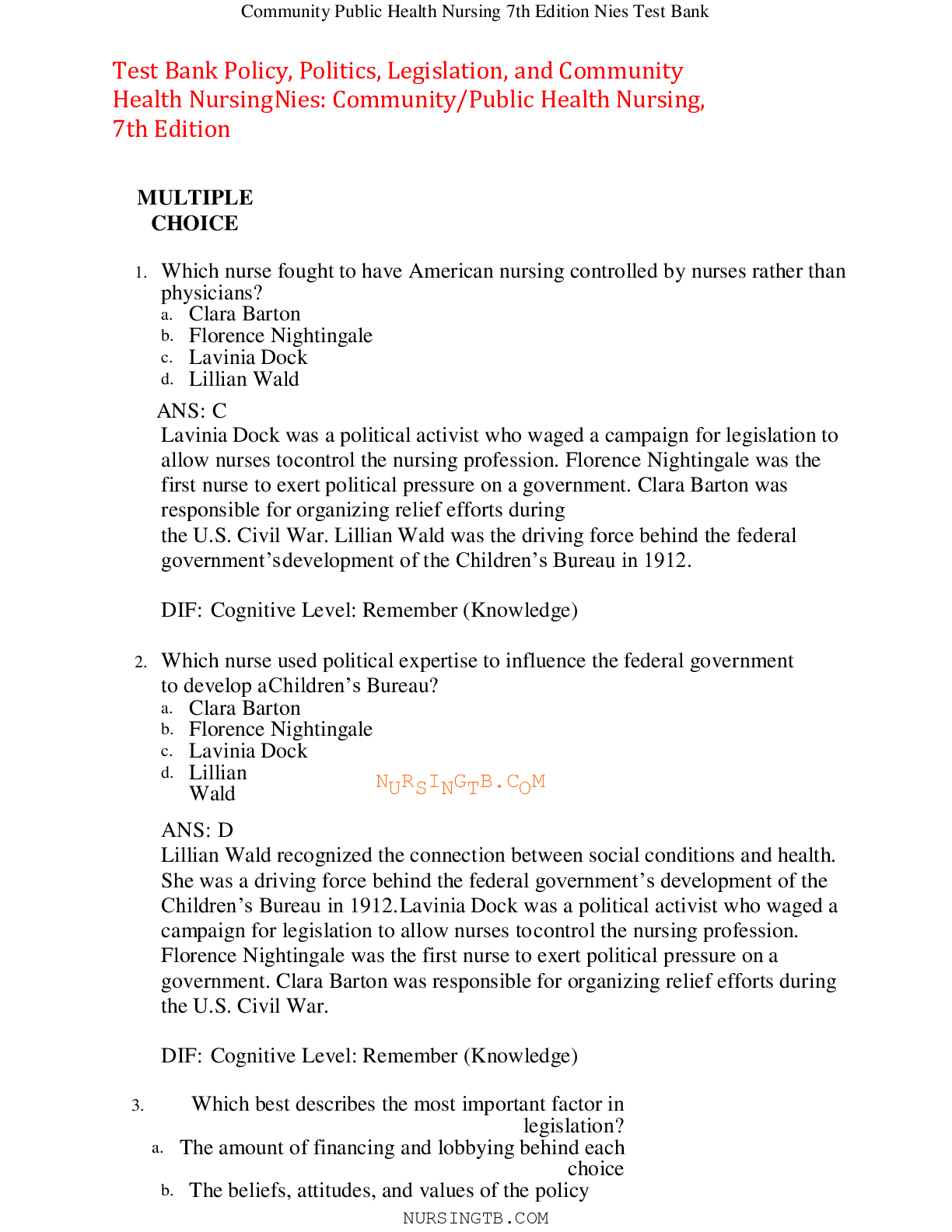


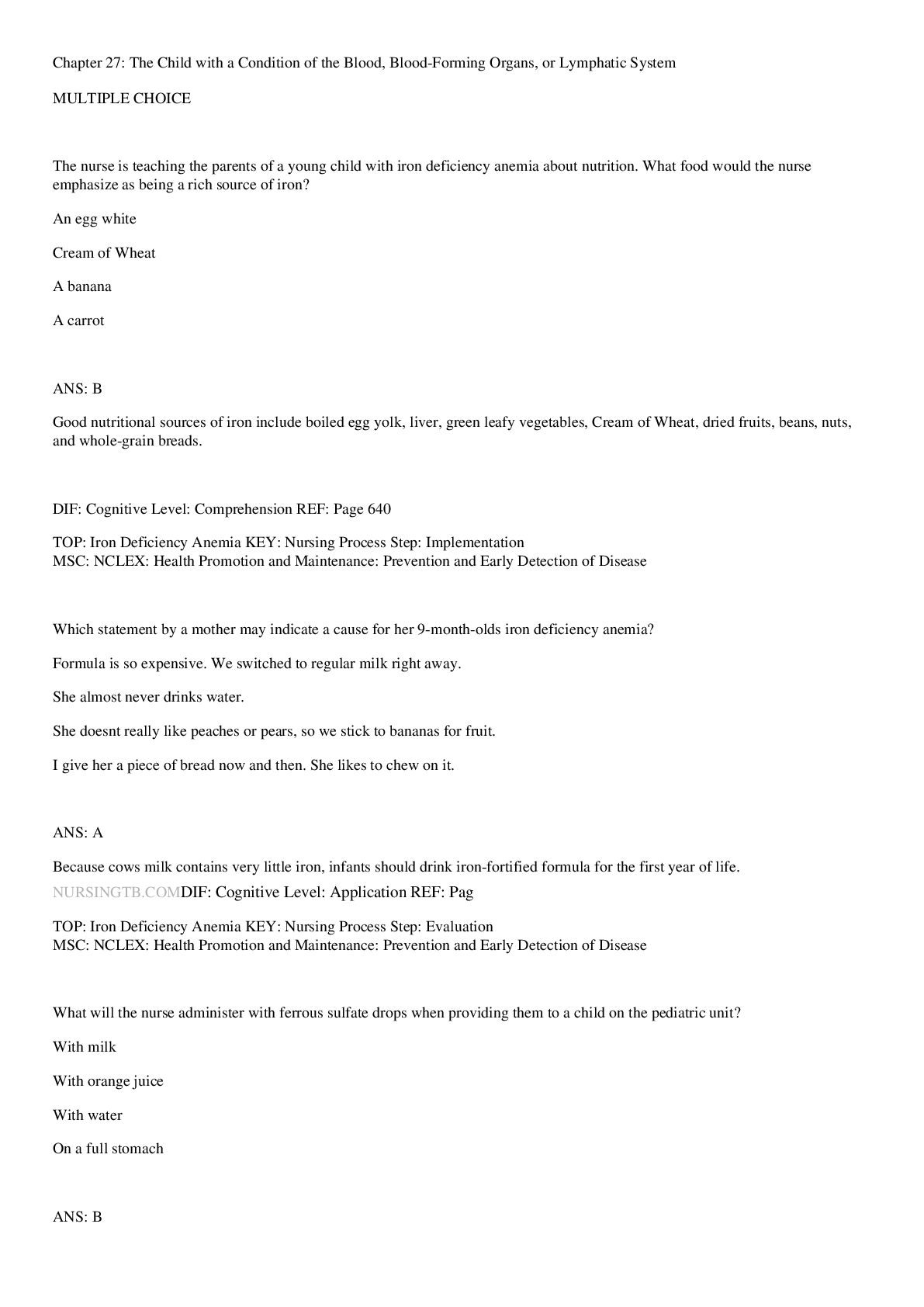



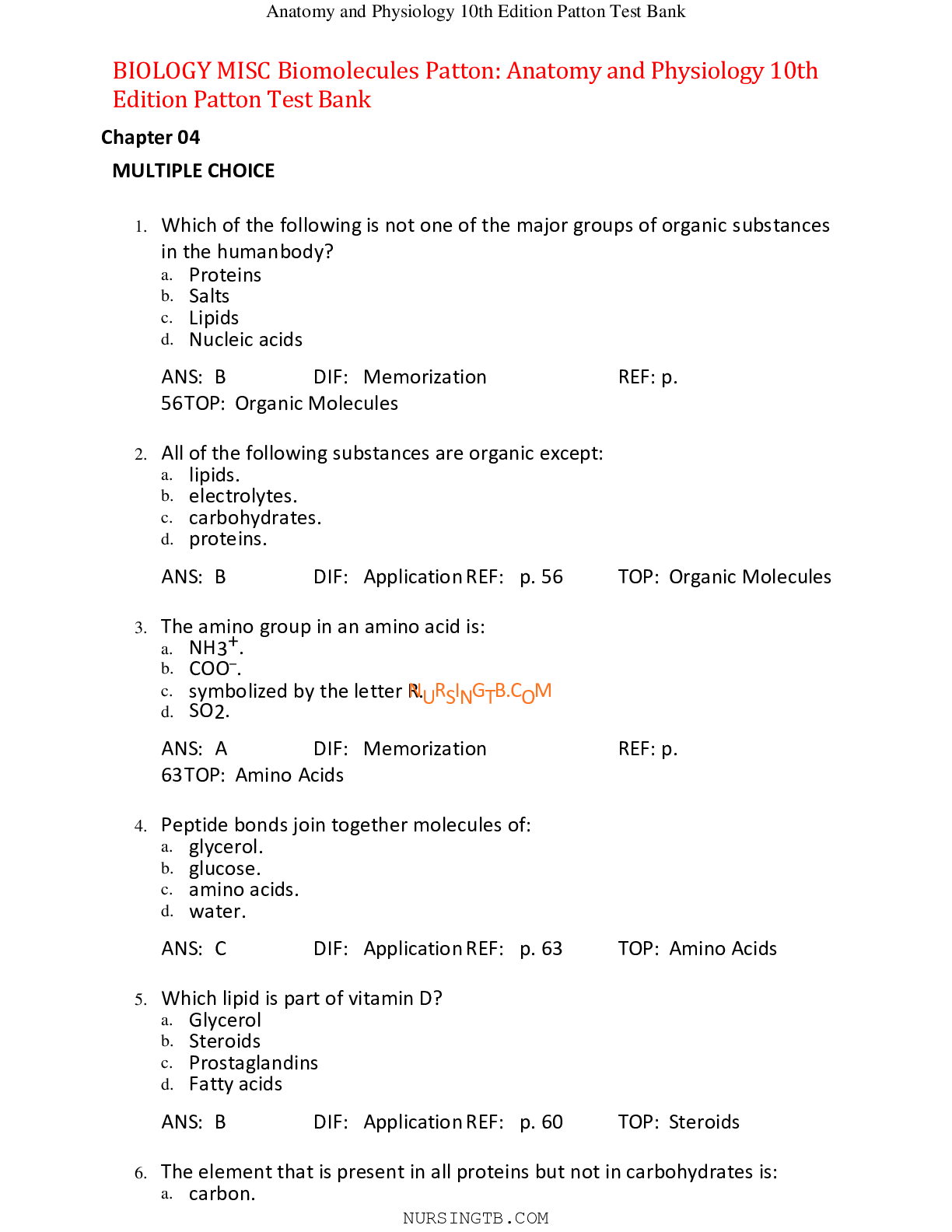







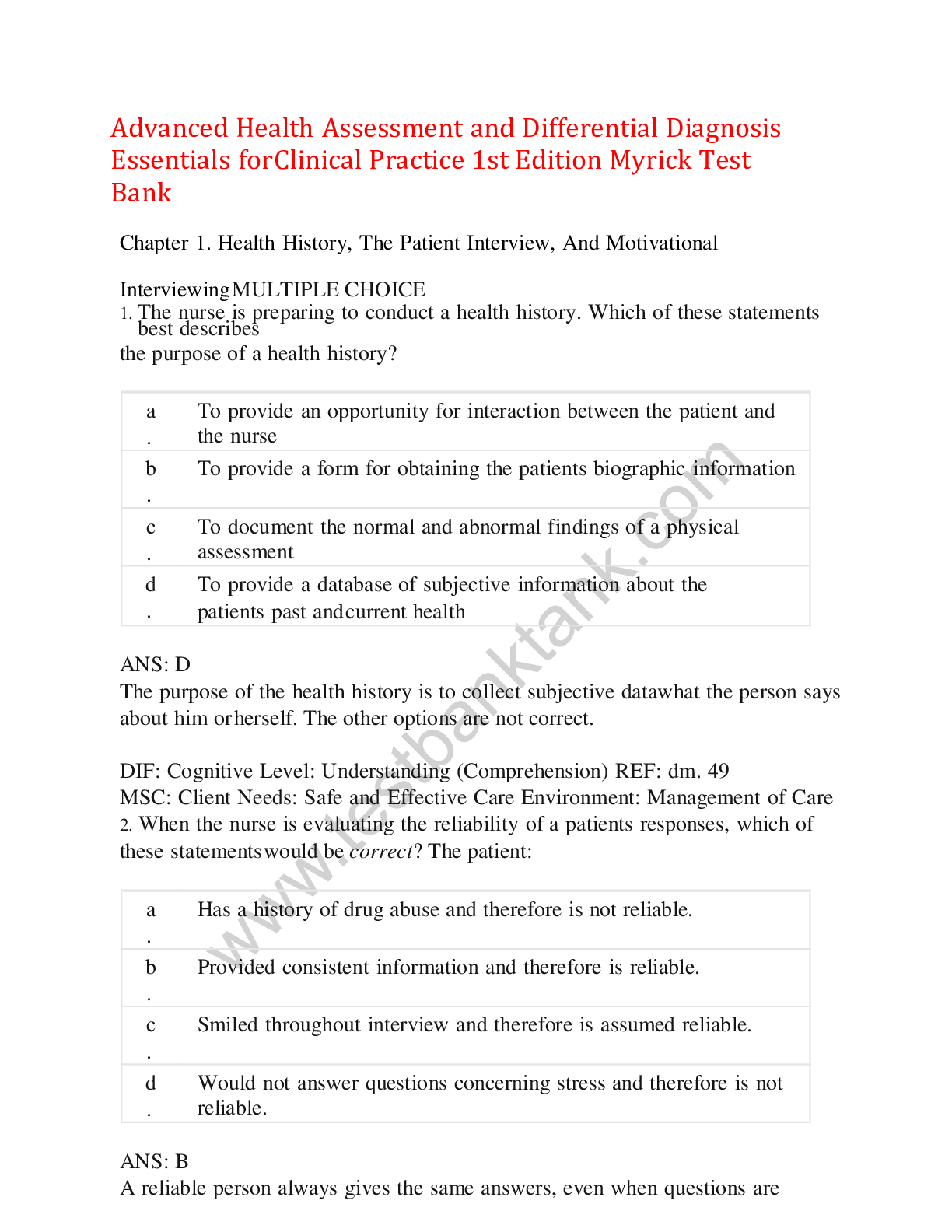
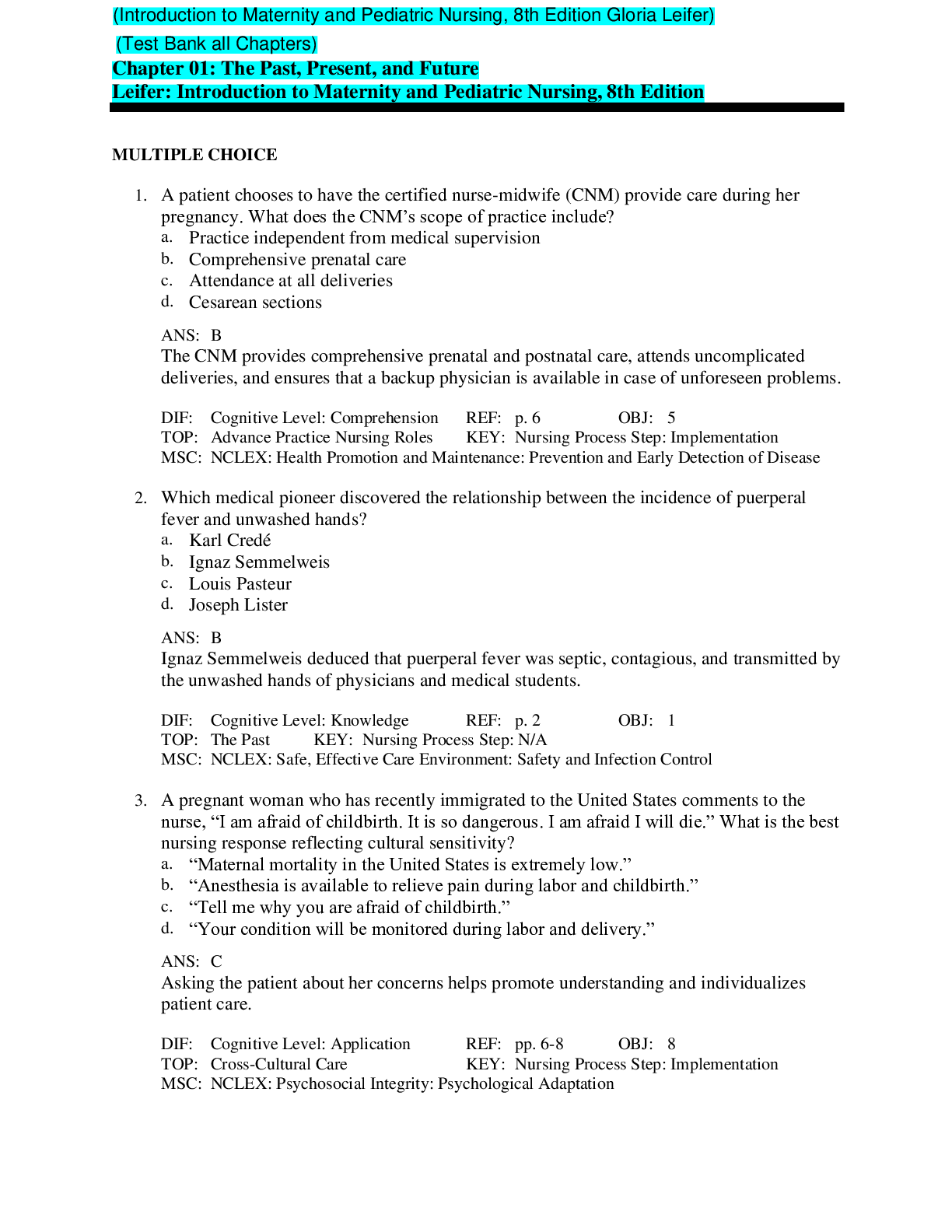



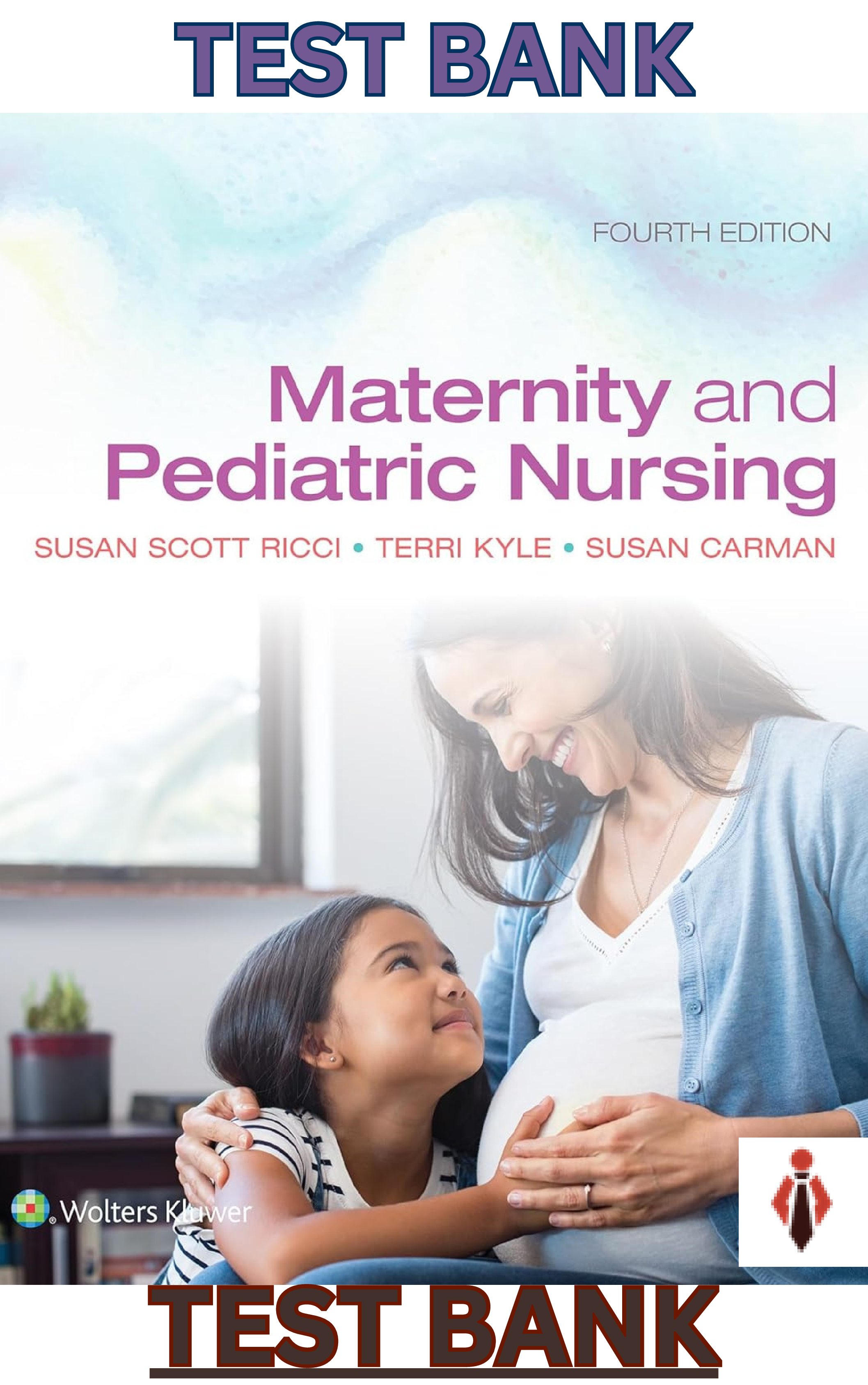
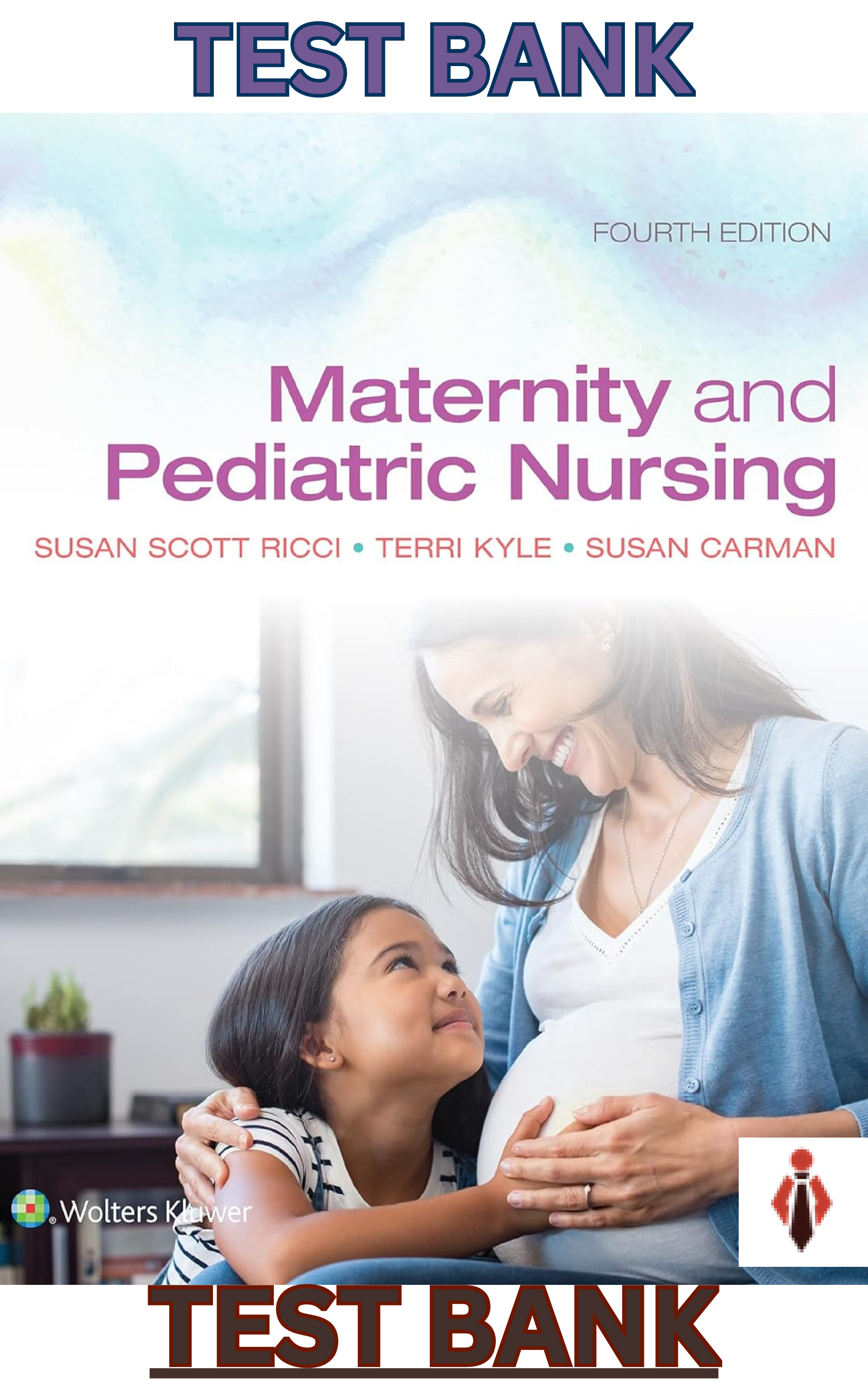
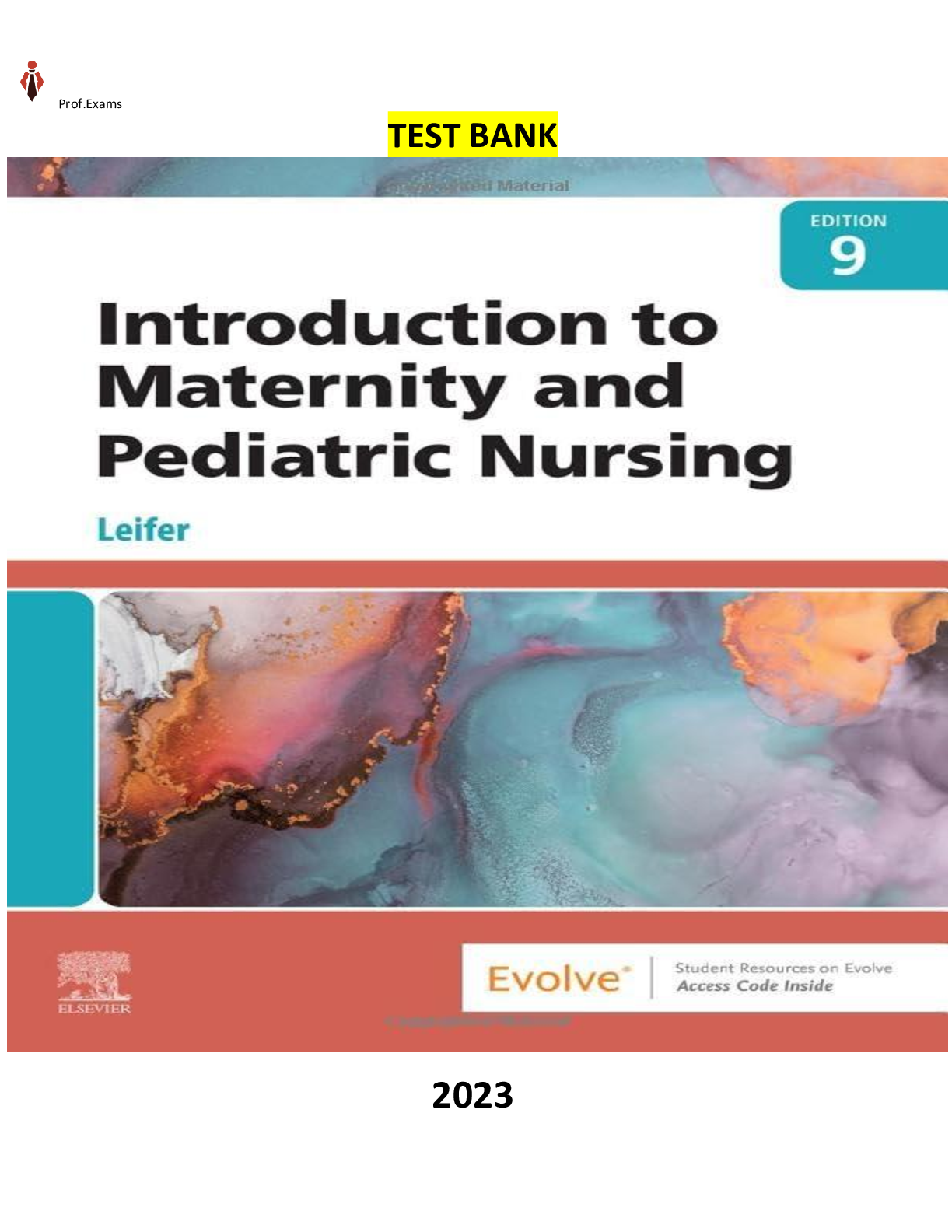
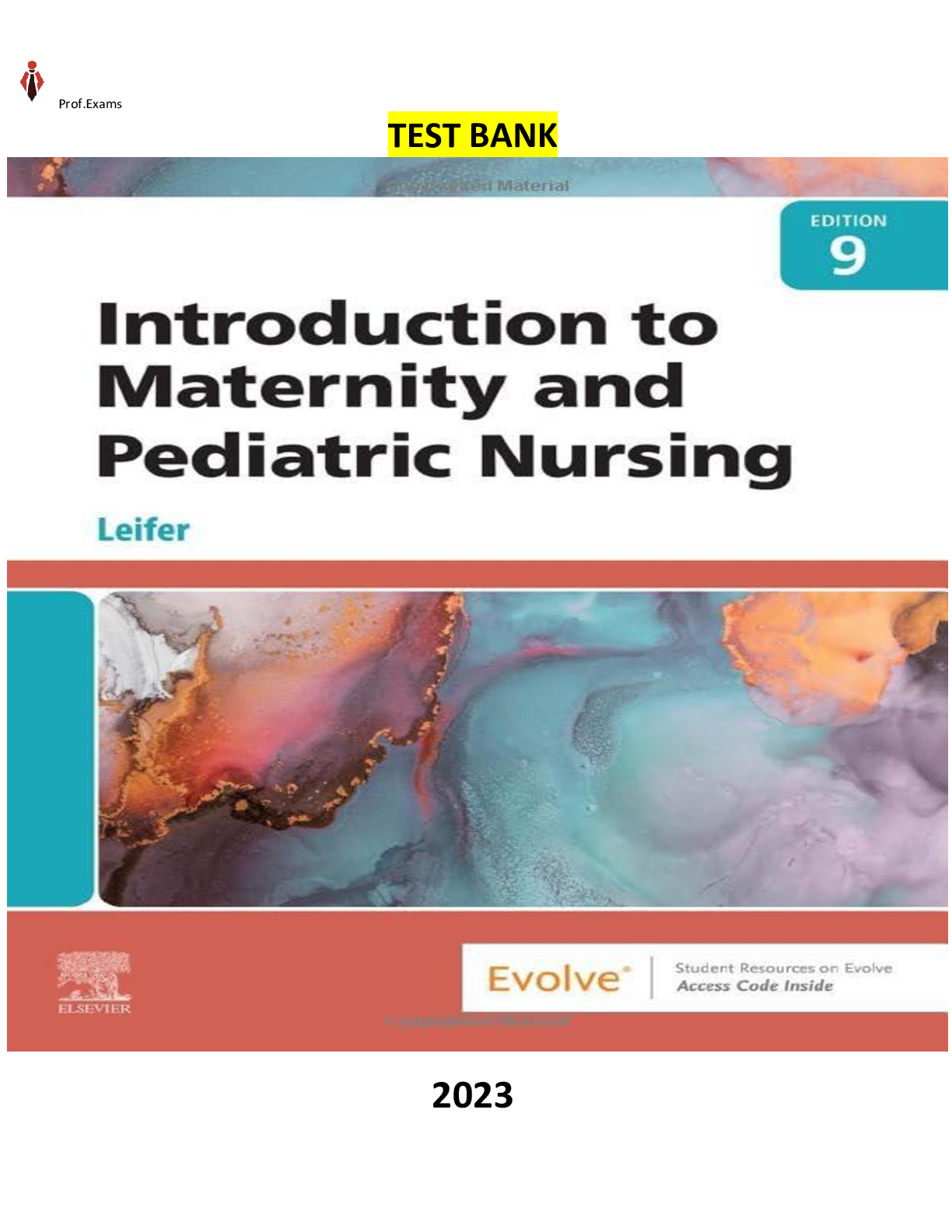
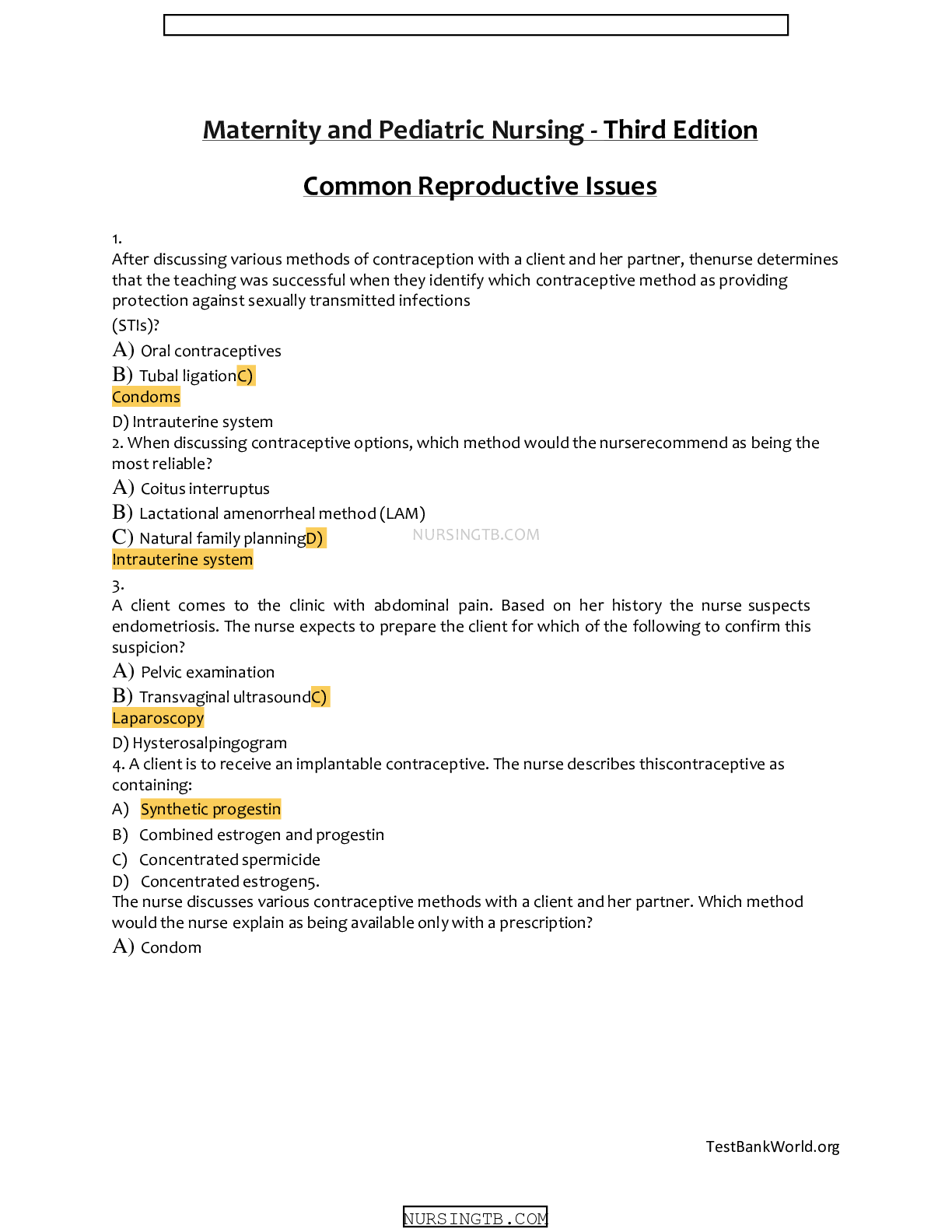
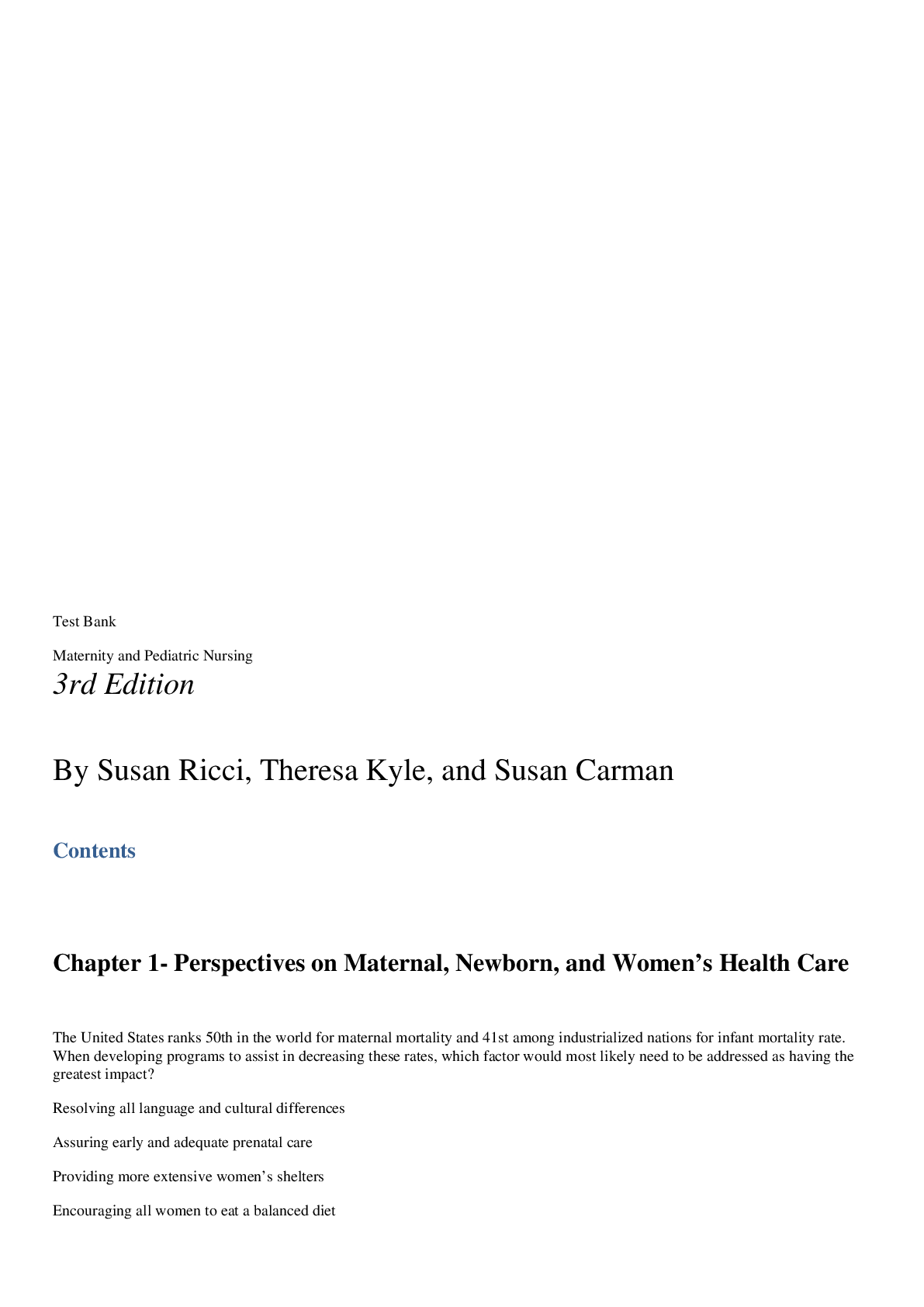
.png)
